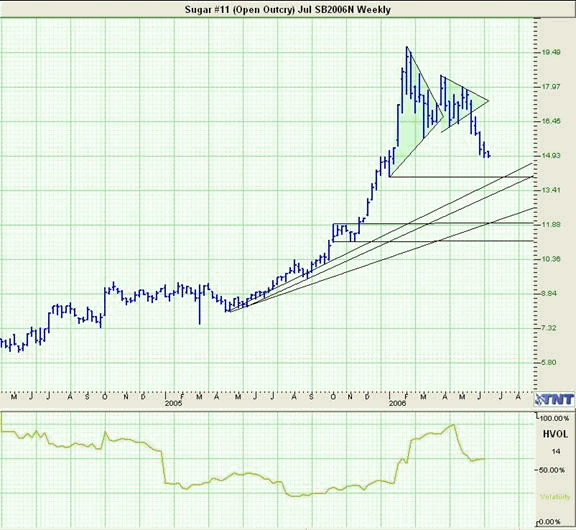Trade Description
Buy one October Sugar 13 put & buy one October Sugar 18 call for a cost of approximately 32 ($358.40). Margin and max risk is the cost of the trade. Options expire Friday, September 9th, 2006.
Explanation
Sugarâ�,��"�s recent breakdown through double pennant consolidation and support has offered intermediate and long term bulls an excellent potential entry point. Recent expanded intraday volume with a tightening trading range indicates a potential bottom along with increasing exposure to massive price moves. Seasonally and technically Jake Bernstein says it best: â�,��"I advised you to 'expect a correction to weekly technical support' based on seasonalsâ�,�¦ it is reasonable and normal to expect large price swingsâ�,�¦that correction is now in process and, if my work is correct, then the decline should end very soon. I do NOT see technical signs of a major top as of this writing. This appears to be nothing more than a pause in the major uptrend for sugar. My next target is in the 23-25 area.â�,�
Buying 18 strike calls with about 3 months of time is a great way to play upside volatility, but adding the put, which at the moment is less than $150, is an inexpensive way to play the chop in this market. Given the current downtrend and potential volatility, the profitability on a major spike higher is potentially tremendous (if it happens quickly), but if the timing is off a bit and the market trends down further then the premium spike on such a rally will be diminished if time to expiration is greatly reduced. The put is so close to the market price by comparison that it offers a great hedge against imperfect timing on the entry of the call side â�,�“ something I think even Jake would agree is the hardest part of trading (timing that is). Additionally, the long option play avoids the pitfalls of futures trading in an extremely volatile market by defining risk and offering unlimited potential reward.
On a final note, Kevin Kerr of CBS MarketWatch, offers this piece of advice in a recent article regarding sugar as it relates to a hurricane season volatility play: â�,��"Sugar is another market that has seen its crops hard hit in Florida and elsewhere from last year's hurricanes. Sugar has the added benefit of being a key ingredient in production of ethanol and is already in high demand.â�,�

Profit Scenarios
Profit scenarios vary by market activity and exit strategy, but in theory is unlimited. The concept behind the trade is that the movement of the market and the increase in value of one side of the strangle exceeds the total cost of the trade. However, if the market looks to have choppy price action, or to trade both positive and negative before the expiration of the options, then legging out of the trade when each side reaches profitability would yield maximum returns. It is recommended to exit one side on a profit of $300 over and above the cost of the trade, and to hold the other side for a possible reversal. If the put side of the trade hits $500-$600 per option, I recommend pulling the entire put side of the position off (as opposed to a leg out) as this will give you a locked in winning trade and a free play to upside.
Risk Scenarios
Max risk is the cost of the trade and occurs at expiration with the market above 13.00 or below 18.00. Loss is reduced by $11.20 per tick below 13.00 to 12.68 (downside breakeven assuming an entry cost of 32). Loss is also reduced by $11.20 per tick above 18.00 to 18.32 (upside breakeven). To reduce exposure it is recommended that you enter into two or more spreads allowing you to implement an appropriate scale out money management exit strategy.
James Mound is the head analyst for www.MoundReport.com, and author of the commodity book 7 Secrets. For a free email subscription to James Mound's Weekend Commodities Review and Trade of the Month, click here.
Disclaimer
There is risk of loss in all commodities trading. Commissions and fees vary per individual and therefore are not included in profit, cost and risk scenarios. Please consult a licensed broker before you trade for the first time. Losses can exceed your account size and/or margin requirements. Commodities trading can be extremely risky and is not for everyone. Some option strategies have unlimited risk. Educate yourself on the risks and rewards of such investing prior to trading. James Mound Trading Group, or anyone associated with JMTG or moundreport.com, do not guarantee profits or pre-determined loss points, and are not held monetarily responsible for the trading losses of others (clients or otherwise). Past results are by no means indicative of potential future returns.